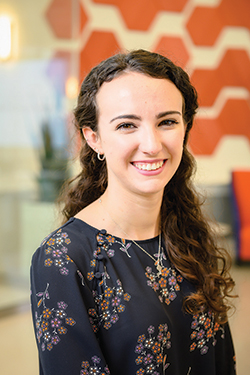The Curator, Erin Brady
Spring
2020
Spotlight on Hidden Physicists
The Curator, Erin Brady
Planetarium and Physics Laboratory Manager, High Point University Sigma Pi Sigma, High Point University, 2018
 In my senior year of college, I knew academia wasn’t for me. I have always been interested in finding new and impactful ways to share my understanding of science with the broader community, and I wanted to find a career path that would allow me to continue these efforts professionally.
In my senior year of college, I knew academia wasn’t for me. I have always been interested in finding new and impactful ways to share my understanding of science with the broader community, and I wanted to find a career path that would allow me to continue these efforts professionally.
As an undergraduate at High Point University, I double majored in physics and studio art while simultaneously dedicating myself to science outreach. While this combination may seem unusual to some, it has set me up to do exactly what I want—explore new ways to share science with the community.
My passion lies in using art by which people can observe scientific information. Specifically, I’m interested in combining art and science to create visualizations that encourage people to think about science in a new way. By bringing together these seemingly disparate skill sets, I’ve created art pieces derived from the analysis of physics data from undergraduates! Each set includes two pieces that show the same data in two different ways: one as a relatively straightforward scientific approach to the data, and the second as an artistic portrayal of the actual data.
A recent example utilizes the data from my research on the Hofstadter butterfly. The first component is comprised of four pieces of glass, with each successive pane showing the butterfly graph with increased disorder. The artistic piece features four triangular origami shapes of paper—two larger pieces and two smaller pieces—arranged in the shape of a geometric butterfly. The origami pieces do not touch, and two are pulled farther outward to represent the increasing disorder in the system. This set is on display in the High Point University art department.
As the Planetarium and Physics Laboratory manager at High Point University, I find new ways to combine science and art to engage with general audiences. This role allows me to work with my three favorite things: physics, art, and outreach. I develop new content for the planetarium and share it with the campus community regularly by putting on shows and demonstrations. I engage with students, faculty, and staff during these shows, and coordinate visits with classes on campus. During this time, visitors experience science (astronomy, earth science, and biology) from a new perspective using the dome and are invited to consider new ways of understanding the world around them.
During a typical demo show, I take visitors on a tour of the universe, the Earth, and the human body using visualization software. I rotate the entire sky to see constellations all over the horizon and fly to another planet while stars zip past. My favorite software to demonstrate is ZygoteBody, which allows me to showcase many different physiological systems within the body. Highlighting one part of a system relative to the whole allows me to convey the interconnectedness and complexity of the body, and I am able to fulfill childhood dreams of hopping on a magic school bus and flying through the human body.
Our planetarium is still brand new, having opened only this past August. As the first person to hold this position, I get to find new ways to integrate other disciplines with the planetarium so that it’s a space that extends beyond the sciences.
Physics careers exist beyond academia, and there is important work to be done in the field even when the word “physics” does not appear in the job title. To the next generation of physics students or anyone looking to make the next step in a career, I invite you to find what you are passionate about and encourage you not to be afraid to apply the skills, knowledge, and techniques you learned from physics in unconventional ways!
More from this Department
Spotlight on Hidden Physicists


